
21.03.2019
By Sara Hermann
Santo Domingo, Dominican Republic
January 25, 2019 – March 9, 2019
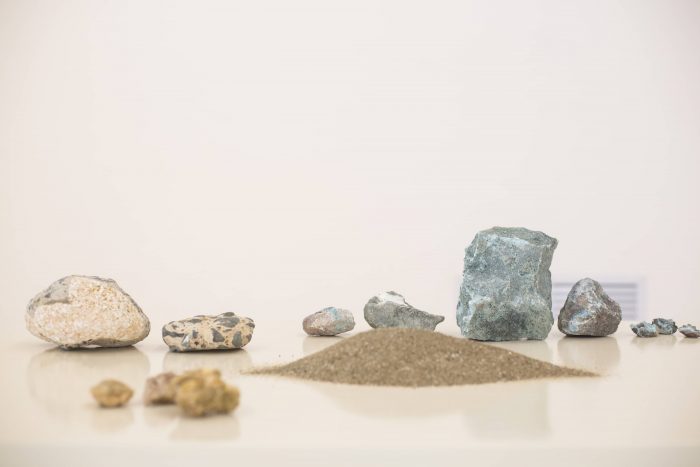
The fact that the space that inhabits the exhibition Canción de la voz florecida [Song of the flowery voice] was originally a studies center where exact sciences such as mathematics, physics, and astronomy were taught, was an unnoticed fact until very recently. The inaccuracy of the history of the so-called Colegio de Gorjón—which today is the headquarters of the Centro Cultural de España in Santo Domingo, Dominican Republic—gathered in part by Fray Cipriano de Utrera [1], shows the instability, fluctuation and insecurity that characterized that place from its origins, both in regard to their means of subsistence and uses, as well as in relation with their owners or regents.
The ability to cross-dress and transfer to the exhibition’s own vessel becomes a key ingredient and symbolic component for the curatorial discourse. Not only the architectural space by itself but the whole environment of that old city. The strip of sea that borders with it was colloquially called “the studios”, in account of those who sat on its shore: with the freshness of its breeze, to review the classes that were taught at the school to unfold meetings and discussions. The sea also provides a basis that develops masterfully in the curatorial discourse, equating it to an action of knowledge, the mutation of a natural body through action and sound, no longer as a metaphor but as a changing reality.
Canción de la voz florecida, composed by Juan Canela and Laura Castro—based on the omnipresent reference of a poem by Franklin Mieses Burgos, a Dominican poet—proposes the reverberation of the uses and customs of the structure or compartment, same that is stressed by the works of Elena Aitzkoa, Engel Leonardo, David Meyreles, Natalia Ortega Gámez, Ernesto Rodríguez, Diego Santomé, Nara Winston and Nika Zhukova and the omnipresent and indispensable Fina Millares.
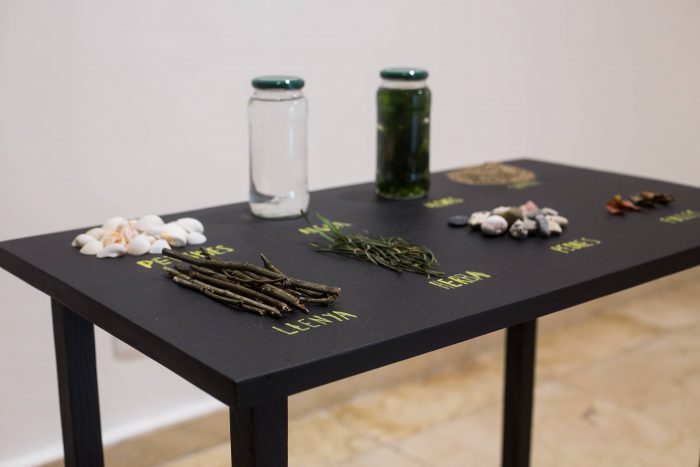
Likewise, from the selection of artists to the analysis of spaces and the “putting into action”,the curators categorically propose a strong relationship between the poetic (in any of its avatars) and the political. The poetic as production and the political as its possible actions in the circumstantial collective. It is not surprising that the voice that governs this canto belongs to one of the fundamental poets of the movement called Poesía sorprendida. This movement emerges at a time when the Dominican Republic was under the totalitarian regime of Rafael Leonidas Trujillo (1891-1961). Many Dominican intellectuals worked in the service of the dictatorship; however, the nucleus to which Incháustegui Cabral belonged posed a rejection of the nationalism that hoisted the dictatorship, while proposing new ways of approaching the poiesis that, in these circumstances of intolerance and repression, also involved a risky political position.
Fina Miralles is the contralto of this song. The balance between the sharpness and gravity of her approaches to the natural space and the fluke of mimesis that she articulates, in conjoined with her compositions—in which sometimes we do not know if it’s the sand, the water or Fina herself speaking—make up an axis from which everything is structured. Each one of the different tones of the artists come together in her work.
Canto… exposes proposals of reinvention of the landscape, not from the territorial perspective but as a new way of looking that eliminates the monumentality of the constructed landscape and returns to more organic, visceral, and, of course, poetic notions. The strategies for this reinvention are drawn from great political actions such as intervention and subversion. The possibility of ingesting, transforming and amalgamating with the landscapes proposed by the artists, makes clear the great ambiguity of this category as a construct that hides the very fact of being and in many ways veils the ideological meanings that support its supposed immutability.
The earth
The configuration of the place with the actions, with the transit, with the engraving as footprint, with the molding and amalgamation of that place, that in between the lines is a nation and outside of them indetermination—without being opposites—it’s all tied to the curatorial approach of the big knot proposed by Nara Winston and Nika Zhukova, who beyond the materiality that stands out (molded Dominican land) make it prevail and predominate the idea of uncertainty and misunderstanding. What do we see, what do we feel, what do we do?
The possibility—which could perhaps be read here as utopian—and the unpredictable—which can be interpreted as the desirable—are perhaps the most sensitive evidence after experiencing the Canción [song]. It had been months since I had not seen the diamonds of Ernesto Rodríguez and the capsules of Natalia Ortega Gámez. His experiments with matter are both immutable and affective. Mixed feelings that are recurrent in each segment of this Canción project. That living matter that mutates strengthens the alterable, the accident, and the conspiracies of time and space in which little can interfere. What we see today is not what we will see tomorrow.
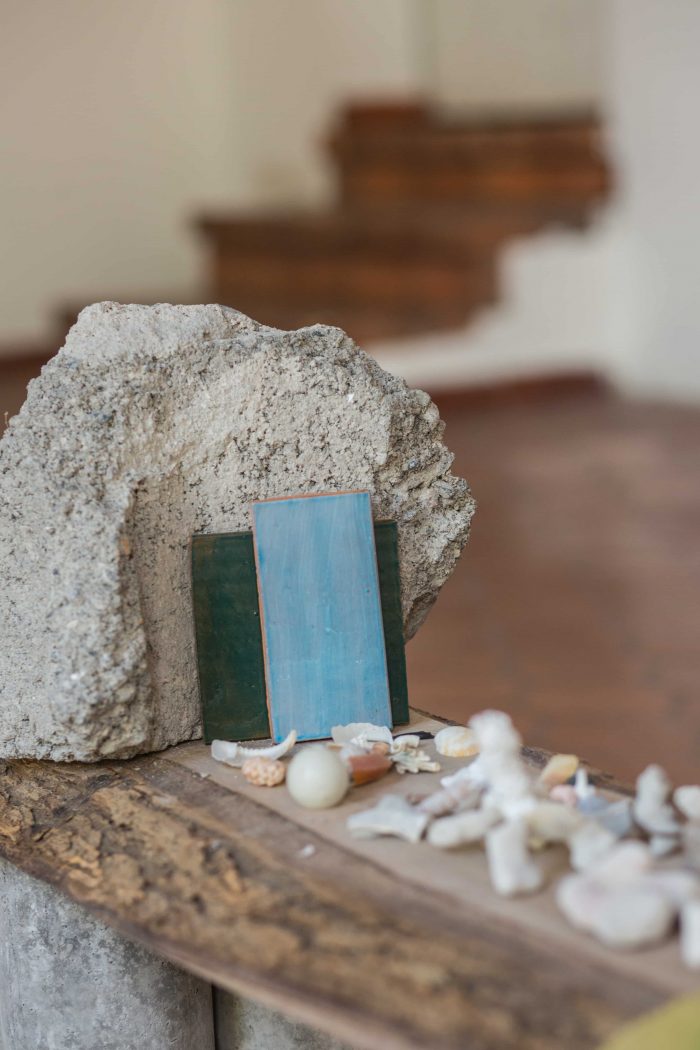
Thus, each song segment is connected in different ports, the binding of each node is a dialogue, soft ties with which we can undo, redo and recompose the project at our whim. The same happens with the pieces by David Meyreles and Fina Miralles, in which the similarity distances itself from equality. And although they are strategically located to provoke a confrontation, each piece of reality and its continent have a completely different tone and feel. The uniqueness of this conversation between works lies in what distances them, in the accident and the meticulousness, between the encounter and the search. The remainder and the evidence are enclosed in containers and bases. The forensic research and the mnemonic resource are linked in both cases to offer us a sense of estrangement as if we had never seen what they call water.
The indetermination of the ideological position of a space and its visuals is marked from a sample of Engel Leonardo. The weight of its mineral archeology, which is part of the study of the materiality of soils, reveals its impact on the sociocultural processes that take place over them. A grain of sand is not always the same; in it evidence is found. The ideas of rooting, belonging, recognition and distancing that the person develops in the lands he treads, although he does not inhabit them, they are managed as a different imprint that has more than one laboratory of emotions than that of the guinea pigs.
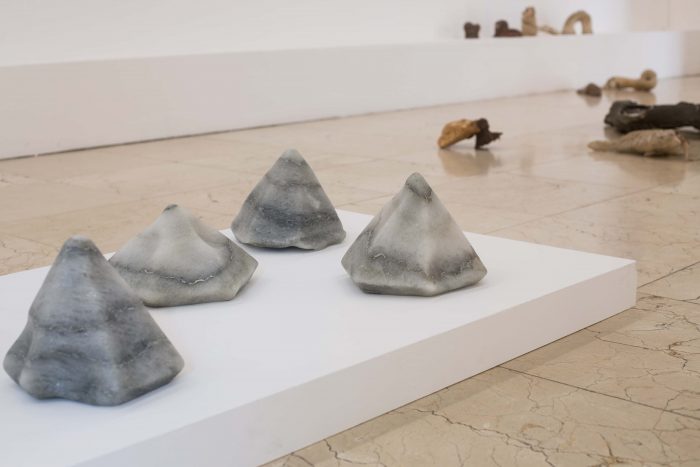
The voice
Canción de la voz florecida also proposes a duel between orality and writing as forms of language production—plural intended because artists who contribute their strength to the exhibition propose sometimes very common voices, other unintelligible, disconnected tones, and neologisms. What are the particular narratives of orality and what nourishes our memory in relation to what is written? Can we talk about linearity and tone? What political and cultural questions are contained in the construction of the subaltern histories in the contemporaneity? Elena Aitzkoa approaches a narrative as an imaginary translation that is produced from the perception of the landscape and its weight as a hypothetical entity. On the other hand, the poetry stunned as movement, upsets the chimera and binds to a land that becomes an organic mass. Aída Cartagena Portalatín, on her Víspera del sueño [Eve of the dream], translated the former in this way:
Tierra se hará silencio,
risa no harán los hombres para que me hagan eterna,
llanto no harán las piedras para que me hagan arena…
[Earth will become silence,
laughter will not make the men to make me eternal,
crying will not make the stones to make sand …]
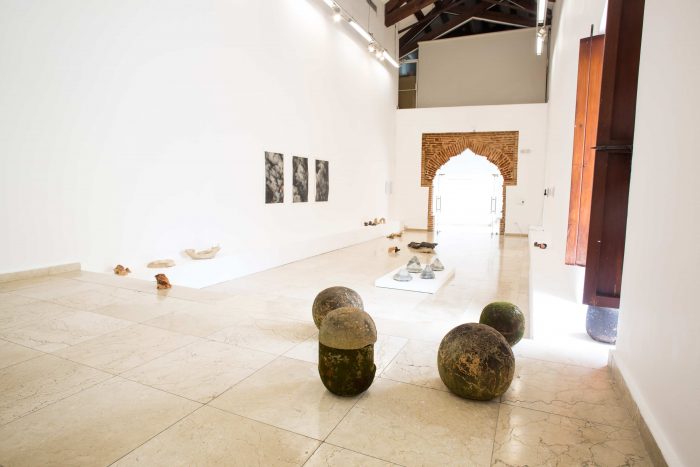
The sea
This forceful body of water is fundamentally a source of stories. It works as a mirror, as a receptacle for the imaginary and as an instrument for spiritual and physical prophylaxis. The characteristics of fluidity, infinite movement, capacity for change and transfer make this a reference also unavoidable. The sea, in the exhibited of Fina Miralles, also embodies a transitory and ambiguous condition; and reinforces the idea of seclusion and isolation that causes being surrounded.
I had to read a lot of what Fina wrote to reaffirm what I saw. She talks about space, the external world—visible, physical—, appearance, time, the inner world, the invisible, metaphysical, the intangible. The black skies of Diego Santomé pull the cable to the ground and I retire.
Universities of Santiago de la Paz and Santo Tomás de Aquino and Conciliar Seminary of the city of Santo Domingo of the Spanish island (Santo Domingo: Capuchin Franciscan Fathers, 1932, 600 pp.).
Comments
There are no coments available.